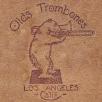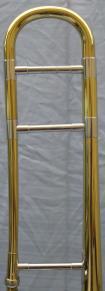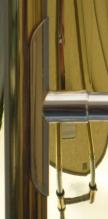
It's a bear!
P-16 "Custom" Trombone
Bore: .500" (12.7 mm)
Bell: 7½" (190.5 mm)
The P-16 was the final small-bore model to be introduced by Olds, appearing sometime around 1977. As with the other "Custom" models, it was situated as the top of Olds line; in 1978, the P-16 listed for $550, compared to $475 for the S-15 Super. Sales literature claims that Burt Herrick, an LA brass tech best known for his mouthpieces and leadpipes, was involved with its design, and that "special alloys selected for resonance and workability in very thin gauges have been used"; a magazine ad from '77 mentions Wayne Andre, along with Eddie Bert, Harry DiVito, Sy Berger, and Bill Porter, and uses the pitchline "Five great trombonists. One great trombone." Great or not-so-great, the P-16 didn't save Olds from shutting down in July of 1979.
From a styling and materials standpoint, it looks rather "generic" as compared to iconic Olds designs like the Super, Studio, and Recording.. It's almost as if the designers went back to the early thirties in the pre-WWII Self-Balancing model; a yellow brass horn with nickel trim and conventional, three-piece cylindrical braces - but I think it more likely Olds was looking to the contemporary Bach 12, Conn 6H, and Martin Committee for inspriation (the single-bore .500" slide and 7½" bell would certainly support that theory). Take away the characteristic Olds slide lock and tenon joint designs and the only way to tell that a P-16 is an Olds is to look at the engraving. One interesting design feature is the elongated flange on the lower end of the handslide brace, intended to provide some protection for the lower slide tube from corrosion due to contact with the player's skin (the Conn 100H employs a similar design)..
As previously mentioned, advertising implies that the P-16 is a light horn, and it is certainly lighter than any other Olds tenor trombone of the same period. The outer slide does not have any added mass (oversleeves or increased wall thickness) at the brace end; in comparing it to a to an early post-WWII Olds outer slide with oversleeves and conventional braces, the P16 slide is about an ounce lighter - and that's comparing to a slide 485"-.500" bore.
This particular horn dates from mid-1978. It came to me without a counterweight, but there is wear on the tuning slide brace indicating that it had one at one point. Images in Olds literature indicate that the counterweight was similar to the one used on late A-15 Ambassadors.
 Overall View |
 Bell Engraving |
 Slide Braces |
 Bell Section Braces |
 End Crook |
 Handslide Brace Detail |